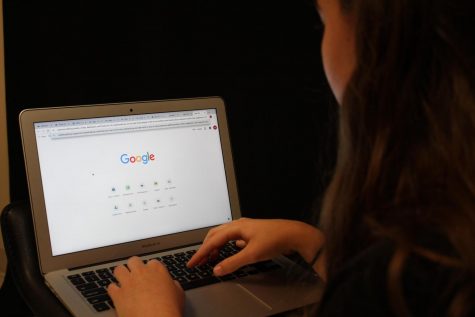Issues: cyberbullying
A cell phone is usually the first thing teenagers see when they wake up, and the last thing they see at night. When we hear that familiar ding from our devices signaling a text, post, or reminder, our first impulse is to respond immediately. Social media dominates the way our generation communicates, and what we have to say isn’t always nice. With just under a third (111/365) of KHS students reporting that they’ve experienced it, cyberbullying is becoming more common than we realize.
Cyberbullying is one of the easiest ways to damage someone’s mental health and self-esteem. With the insecurities that come with growing up, sending a hurtful comment or posting an embarrassing photo won’t exactly boost someone’s confidence. Middle and high school students especially struggle with cyberbullying due to the hours we spend on social media platforms each day.

Cyberbullies who hide behind a screen don’t see the emotional response of their target.
Many people take comfort from the fact that they can voice their opinions and personal experiences behind the anonymity of a screen. According to Abby Peterson, KHS guidance department chair, cyberbullies feel more powerful in a position where they can’t see their victim’s reaction. Online, there’s no visible emotional response that allows cyberbullies to fully understand the negative impact they had on someone else, along with the consequences that come with posting something for the world to see. If a KHS student came to Peterson about cyberbullying, the first thing she would do is verify that what’s going on really classifies as cyberbullying, which she defines as “constant bothering of somebody else via a social media outlet.” Peterson would then contact an administrator and gauge how intense the situation is at first, and depending on the intensity, it may be more appropriate to call home or to get police involved. Mike Wade, associate principal, would take a similar approach by asking to see screenshots or examples of the cyberbullying.
According to Wade, KHS has a no-tolerance policy when it comes to bullying of any kind. and the school will impose severe punishments, including suspension, in order to stop the bullying. Administrators like Wade can suspend students for up to 10 days, and any punishment longer than that would have to be approved by the superintendent. Wade said he has at least one conversation each week regarding hurtful posts, usually from Snapchat. As students begin to use social media at increasingly younger ages, cyberbullying cases can also happen at the middle and elementary school level, though Wade believes cyberbullying is most harmful in high school.
What people going through cyberbullying need most is support, whether it be from family, friends or teachers. By simply taking a minute or two out of the day to make someone else smile, you could be helping them get through a tough time. Sending positive messages for this purpose could be called “cyberbuddying.” Don’t limit who you send these positive messages to, though. Leaving a friendly comment on a classmate’s post or catching up with a friend from summer camp will not only make them feel happier, but it will make you feel happier, too.
It costs nothing to be kind, yet people don’t do it enough. It only takes a moment to text family members how much you love them or to say thank you to the friend who helped you with homework the other day. Having social media platforms and other ways of digital communication at our fingertips makes it easier than ever to spread positivity, so take advantage of it. It may just come back around when you need it most.
Right now, people are preventing cyberbullying by teaching kids and teens to report, block and have conversations about what they see online. By educating not just victims, but cyberbullies themselves about how their actions affect others, we can build empathy and help this issue happen less often.
Your donation will support the student journalists of Kirkwood High School. Your contribution will allow us to purchase equipment and cover our annual website hosting costs.

Interests: Photography/editing photos, graphic design, reading, and spending time outdoors.
Favorite musical artist: Shawn Mendes.
Favorite quote:...

Interests: Golf, art, photography, and ultimate frisbee
Favorite quote: "Success depends less on strength of body than upon strength of mind character"...







